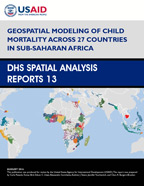
Abstract:
Preventable mortality of children has been
targeted as one of the UN’s Sustainable
Development Goals for the 2015-30 period.
Global decreases in child mortality (4q1)
have been seen, although sub-Saharan Africa
remains an area of concern, with child
mortality rates remaining high relative to
global averages or even increasing in some
cases. Furthermore, the spatial distribution
of child mortality in sub-Saharan Africa is
highly heterogeneous. Thus, research that
identifies primary risk factors and
protective measures in the geographic context
of sub-Saharan Africa is needed. In this
study, household survey data collected by The
Demographic and Health Surveys (DHS) Program
aggregated at DHS sub-national area scale are
used to evaluate the spatial distribution of
child mortality (age 1 to 4) across 27 sub-
Saharan Africa countries in relation to a
number of demographic and health indicators
collected in the DHS surveys. In addition,
this report controls for spatial variation in
potential environmental drivers of child
mortality by modeling it against a suite of
geospatial datasets. These datasets vary
across the study area in an autoregressive
spatial model that accounts for the spatial
autocorrelation present in the data.
This study shows that socio-demographic
factors such as birth interval, stunting,
access to health facilities and literacy,
along with geospatial factors such as
prevalence of Plasmodium falciparum malaria,
variety of ethnic groups, mean temperature,
and intensity of lights at night can explain
up to 60% of the variance in child mortality
across 255 DHS sub-national areas in the 27
countries. Additionally, three regions -
Western, Central, and Eastern Africa - have
markedly different mortality rates. By
identifying the relative importance of
policy-relevant socio-demographic and
environmental factors, this study highlights
priorities for research and programs
targeting child mortality over the next
decade.
 Geospatial Modeling of Child Mortality across 27 Countries in Sub-Saharan Africa (PDF, 5482K)
Geospatial Modeling of Child Mortality across 27 Countries in Sub-Saharan Africa (PDF, 5482K)
